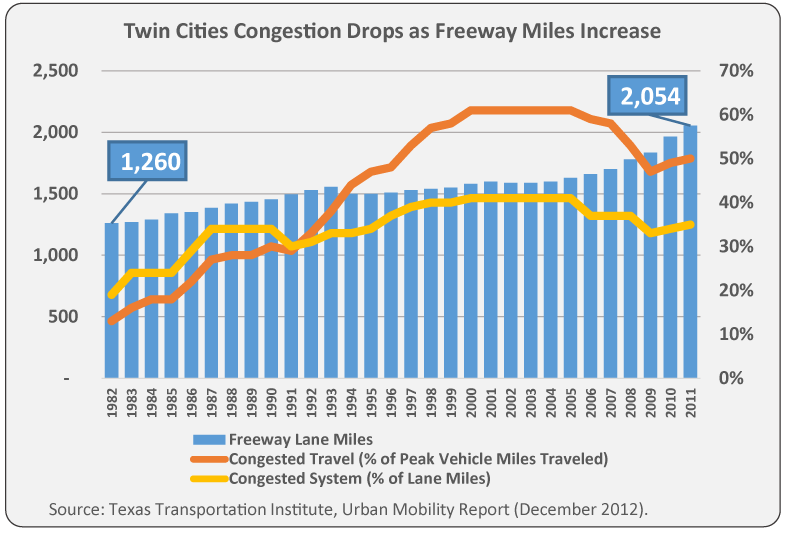New lane miles do reduce congestion
Road construction season is in full swing and it feels like one of the worst ever. Any trip I make seems to be obstructed. Get off the freeway to avoid traffic and I run into a construction crew milling and overlaying what I thought would be a traffic free city street.
Despite all this frustration, I know it could be worse.
In preparing the transportation chapter for American Experiment’s Minnesota Policy Blueprint, we uncovered what seems to be a little known fact. Minnesota added a substantial amount of new freeway lanes to the Twin Cities transportation network from 2004 to 2011. Over this time, freeway lane miles increased from 1,600 to 2,054, a 28 percent increase.
Without these new lanes, congestions would be much worse today.
Data from the Texas Transportation Institute (TTI) at Texas A&M University in the chart below, published in the Blueprint, shows congestion began dropping not long after lane miles began increasing.

No doubt much of the drop in congestion is tied to the fact that the Great Recession reduced the number of people commuting to work. But the Great Recession only explains so much. New lane miles have had an impact.
Congestion starting dropping in 2006, which is about 2 years before employment began dropping in the region. Unfortunately, the TTI data does not extend beyond 2011. TTI’s new 2015 Urban Mobility Scorecard did not update the number of freeway lane miles and changed how they calculated congestion, making it impossible to update the chart.
So, we must turn to congestion data reported by the Minnesota Department of Transportation (MnDOT) and this shows congestion has remained stable even as employment has grown. MnDOT’s 2014 congestion report shows 21.1 percent of the Twin City urban freeway system is congested, which is nearly identical to the congestion level reported since 2010. Thus, upward congestion trends appear to at least have stalled after adding lane miles.
Note that MnDOT data does not show the same level of congestion relief as the TTI data. This may be due to the fact that TTI data measure congestion across the entire road network, not just freeways. MnDOT data may be missing the positive impact addition freeway lane miles contribute to congestion relief on city streets.
Of course, advocates for shifting investment from roads to light rail and other transit argue these new lane miles do nothing to ultimately reduce congestion. They argue freer moving traffic induces demand to use the roads, which eventually fills the roads to the previous congestion level. A professor at the University of California Davis actually asserts “reductions in roadway capacity tend to produce social and economic benefits without worsening traffic congestion.”
That’s in sharp contrast to the folks at Texas A&M who provide instruction on how “adding new lanes to an existing road or building new roads can reduce congestion and provide alternate routes for commuters.”
Of course, there is some truth to the claim that new lanes will fill right back up. Build more lane miles on a road and more people will begin using the road, especially when the road is free.
But these roads aren’t just filling up with people that would otherwise be staying home. The congestion relief new lanes provide is one thing that attracts people to move to a city.
Filling new lanes with new Minnesota residents is very important to Minnesota’s future. According to the Minnesota demographer, the state has been, on net, losing people to state-to-state migration ever since 2001. This fact is also shown in the IRS data I analyzed for the report, Minnesotans on the Move to Lower Tax States 2016.
“Positive migration,” as the demographer concludes, “is key to fueling our economy and maintaining a high quality of living in Minnesota in the years to come.”
Congestion relief is an important part of the solution to attract more people to live and work here.
Unfortunately, MnDOT’s policy to reduce congestion during Gov. Pawlenty’s administration is no longer in force. The most recent MnDOT performance report admits, “Since 2010, MnDOT’s strategy has shifted from reducing congestion toward providing alternatives to congested travel.”
Alternatives?
For most Minnesotans, there is no alternative to getting in a car and commuting across town to work, carpooling kids to a soccer game, picking up a load of mulch at Menards or taking grandpa to the eye doctor.